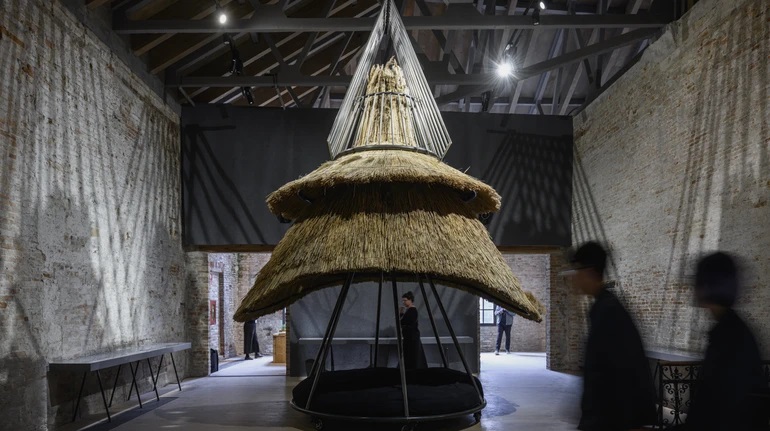Ukraine presents “architecture of resistance, memory and future” at the Biennale in Venice
15 May 09:42
At the 19th International Architecture Exhibition La Biennale di Venezia, the Ukrainian pavilion introduces visitors to the project DAKH: Vernacular Hardcore” project, which is dedicated to the phenomenon of the roof as a symbol of protection and security, especially in times of war. This was reported by the Ukrainian Institute, "Komersant Ukrainian" informs
This year’s theme of the Biennale is “Intelligens. Natural. Artificial. Collective” – Intelligence. Natural. Artificial. Collective.
“It was within this framework that we presented the project DAH: Vernacular Hardcore” – a conversation about the roof, about home, about war and reconstruction. The word “roof” is almost impossible to translate into English, because neither roof nor ceiling convey what it means for Ukrainians to have a roof over their heads during the war. For us, “roof” is not just an architectural element. It’s about protection, and it’s about home, it’s about the house and our shelters, about the metaphorical and the real. The pavilion is a modern reinterpretation of the traditional reed roof created in Ukraine,” Alyona Shkrum, First Deputy Minister of Communities and Territories Development of Ukraine, who opened the pavilion, described the concept of the Ukrainian pavilion.
the “roof” in the exhibition concept is a basic element of architecture, and therefore simultaneously refers to wartime and postwar reconstruction. “Roof”, a dynamic prototype of a Ukrainian roof, was designed by architect and artist Bohdana Kosmina.

What else can be found in the Ukrainian pavilion
The exposition, for example, features selected materials from the archive of the Atlas of Traditional Ukrainian Housing from the Late 19th to the Mid-20th Century, a 50-year monumental study that was created by three generations of female architects: Tamara, Oksana, and Bohdana Kosmina. The archive became the basis for the creation of DAKH, and the images from the research influenced its form, structure, materiality, and spirit.
“Places: Mykolaiv Region” is a photographic project by artist and writer Yevheniia Belorusets that explores landscapes dehydrated by war. “Dome of Drones” is an immersive sound installation curated by Clemens Poole and inspired by the Klin project, a grassroots drone initiative led by Ksenia Kalmus. Visitors will also be able to evaluate these two projects.
There is also a place at the exhibition for a project to rebuild Mariupol
The Mariupol Reborn team was invited to the 2025 Biennale as part of the French Pavilion. They presented a project to rebuild Mariupol after the de-occupation.
To create the project, 4 architectural teams (Ro3kvit, Mriya, Big City Lab, and Zotov & co) were united into a single team. Each team was responsible for a separate layer of research and design.

The vision for the rebuilding of Mariupol was the result of more than six months of work by a team consisting of residents of Mariupol and Ukrainians from other cities, as well as experts from Europe and the United States. This vision covers areas such as identity, memory and the future, environmental strategy and rethinking the role of nature in the city, as well as ensuring the comfort of residents and the quality of life in the urban environment at every stage of development.
In Venice, Ukraine is trying to tell the world about the scale of the destruction
“More than 2.5 million Ukrainian ‘roofs’ – apartments, houses, schools, kindergartens – have been destroyed or damaged during the war. These were the figures that were announced at the opening of the Ukrainian cemetery.
It was also said that, for example, in the Kyiv region, more than 21,000 out of 30,000 damaged objects have already been restored. This is a reminder of the scale of the reconstruction that has already begun.
As you know, it is the housing sector of Ukraine that remains the most affected by the war, with direct losses estimated at $60 billion. According to the Kyiv School of Economics, as of November 2024, 236,000 residential buildings were damaged or destroyed, of which 209,000 were private houses, 27,000 were apartment buildings, and another 600 were dormitories.
Regionally, Donetsk, Kharkiv, Luhansk, Kyiv, Chernihiv, and Kherson regions suffered the most damage.









